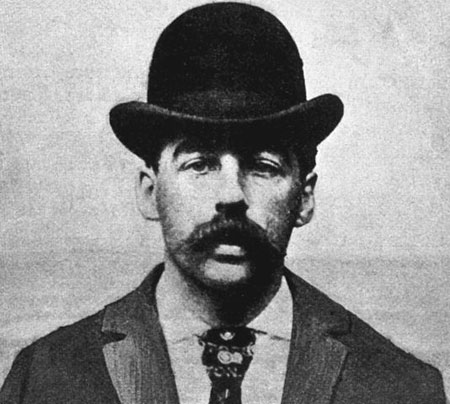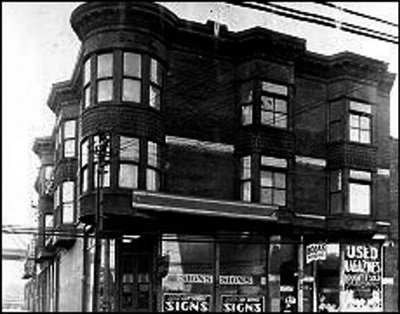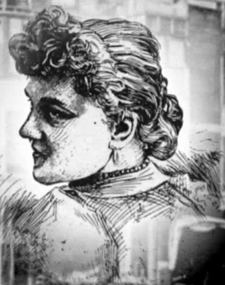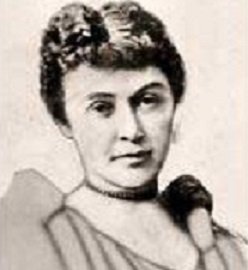Henry Howard Holmes, the Death Doctor of Murder Castle
 Nowadays, most people aren’t afraid of monsters. We know that our neighbours are not secretly werewolves, that the dead will not rise as vampires to steal our lives away, that witches will not cast malicious curses to blight our lives. And yet, there are monsters who walk among us, monsters with human faces. Serial killers are the modern boogeymen – hiding among society, picking victims on a whim and snuffing out lives for their own hideous pleasure. The kindly old doctor turns out to have murdered hundreds of his elderly patients. [1] The businessman in the nice suit turns out to be luring victims to abandoned warehouses and murdering them, before forging papers to steal their possessions. [2] The bright young law student with a promising future in politics turns out to have raped and murdered dozens of young women. [3] Of course, those who killed compulsively for pleasure have been around for centuries, but it took the rise of mass media to turn the serial killer into a phenomenon. In England, it was Jack the Ripper who was the first killer to attain this level of notoriety. The following decade, an even more prolific and terrifying killer became the first prominent American serial killer, a man who would kill not out of passion but simply because it was more convenient for him for you to be dead. The name he became notorious under was one he gave himself – Doctor Henry Howard Holmes.
Nowadays, most people aren’t afraid of monsters. We know that our neighbours are not secretly werewolves, that the dead will not rise as vampires to steal our lives away, that witches will not cast malicious curses to blight our lives. And yet, there are monsters who walk among us, monsters with human faces. Serial killers are the modern boogeymen – hiding among society, picking victims on a whim and snuffing out lives for their own hideous pleasure. The kindly old doctor turns out to have murdered hundreds of his elderly patients. [1] The businessman in the nice suit turns out to be luring victims to abandoned warehouses and murdering them, before forging papers to steal their possessions. [2] The bright young law student with a promising future in politics turns out to have raped and murdered dozens of young women. [3] Of course, those who killed compulsively for pleasure have been around for centuries, but it took the rise of mass media to turn the serial killer into a phenomenon. In England, it was Jack the Ripper who was the first killer to attain this level of notoriety. The following decade, an even more prolific and terrifying killer became the first prominent American serial killer, a man who would kill not out of passion but simply because it was more convenient for him for you to be dead. The name he became notorious under was one he gave himself – Doctor Henry Howard Holmes.
Holmes was born as Herman Webster Mudgett in 1861, to a prosperous farming family in Gilmanton, New Hampshire. He was reputedly frequently bullied by other children growing up. One story has it that he was terrified of the idea of death until the other children forced him to touch a skeleton kept in the local museum, after which his fear was replaced with a fascination. He was a very intelligent child and did well at school. In 1878, aged only 17, he married Clara Lovering, and two years later they had their first (and only) child. Clara’s family were wealthy, and they paid for Holmes to study medicine at the University of Michigan, which he graduated from in 1884. At university he began his criminal career, and Henry Howard Holmes was the persona he took on to do it. As a medical student he had access to dead bodies that were used for dissection. He took advantage of this by taking out life insurance policies on fictional individuals, and then mutilating the cadavers and using them to get a death certificate he could use to claim the insurance. How often he did this is unknown – at least once, and possibly more. He was smart enough to avoid being caught by over-indulging, but it opened his eyes to the myriad possibilities for fraud that life insurance offered.
After he graduated his wife and child moved back to New Hampshire, but Holmes didn’t accompany them. Instead he simply abandoned them, heading off to Chicago. This city would be his home, and later hunting ground, for the next decade. In Chicago he tried to pull his fake life insurance scam one more time, but couldn’t bring it off. He then tried his hand at legitimate business, setting up a company to produce copying machines, but it was a failure. In 1886 he became the clerk at a drugstore, and supplemented his income with more fraudulent schemes. One common fraud he practised was a pyramid scheme of debt, taking a loan out to buy a lot, then (pretending to own the lot outright) using it as security to take a loan to build on it, cheating the workmen who built the property and skimping, buying furniture to furnish the house on credit and selling it off to pay the workmen, then selling the house and disappearing, leaving the hapless new owner to face the bailiffs from the furniture company. This was a successful enough scheme that he was able to buy out the chemist’s store and own it himself, and would later fund his most ambitious venture, when he bought the lot across the street and began building a large hotel there – the infamous Murder Castle.

In 1887 he had married again, this time to a woman named Myrta Belknap. He didn’t get around to filing for divorce from Clara until a few weeks later, and even then he never bothered following up and finalising it. Rules like that, he clearly believed, were for other people. While his wife lived in the suburbs, he kept a mistress above his drugstore (and later in the Castle), a woman named Julia Connor who left her husband for him. He clearly had a power to compel people – his two chief accomplices, Minnie Williams and Benjamin Pitzel, seem to have been totally in his power. Pitzel was a frequent assistant in Holmes’ fraudulent schemes, and the two would often bail each other out of jail. Minnie was a teacher originally, who fell for a dashing intelligent young man she met in Mississippi – Holmes – out travelling to commit frauds. He brought her back to Chicago, and she would write to her aunt and claim that she had married him, though this may not be true. [1] What is probably true is that she led him to commit murder for the first time, killing the inconvenient Julia (and her daughter) to clear the way for the younger, more attractive, Minnie. Minnie also sent for her younger sister to come and join her, but shortly after the sister arrived she vanished. Holmes would later claim that Minnie had actually murdered her in a fit of jealousy, but this was never proved. Several other young women also came to work for Holmes, or came to be his mistresses, during this period. They all vanished into the Murder Castle, never to be seen again.
The Castle was, from the outside, a fairly ugly grey building, three stories tall and with nearly a hundred rooms in total. On the ground floor it was divided into shops, and Holmes moved his drugstore business into one of these. The other two floors were ostensibly a hotel, including large apartments for Holmes himself. As you walked around this hotel, however, one can imagine a certain sense of disquiet creeping in. The layout was labyrinthine, with hallways turning back round on themselves, apparent stairways that did not connect actual floors, hinged walls that could be moved to rearrange the layout of rooms, and doors that opened onto solid brick walls. This concealed the secret rooms, dotted throughout the building, soundproof and windowless. A secret passage running along the second floor had a wooden chute that went straight down to the surprisingly spacious basement and similar chutes were found in other parts of the hotel. As Holmes built it he would fire contractors and hire new ones, so that nobody but him knew the true layout of the hotel – or its sinister purpose. In fact, the entire place was constructed as a deadly trap for those who entered. Some of the hotel rooms had gas jets built into the walls to allow him to kill guests as they slept. Others had secret connections to the soundless rooms, where he would take guests (or his unfortunate young female employees) in order to take a little more time in killing them.

Even though he murdered between 20 and 200 people over the years of 1892 and 1893, Holmes was never suspected of being a killer. The truth was that Chicago was, at the time, a city composed mostly of travellers. The great World’s Fair was in town, and the city was full of transients. Most of those Holmes hired and killed, or who stayed as paying guests in his apartments and never left, were from out of town, with nobody to miss them. Those who did assumed they had just gone home. Holmes had a talent for spotting women with access to money who would not be missed, and he did well out of it. Profit was only a part of it, however. He had an obsession with the occult, and believed that he could gain some knowledge from studying the art of dying. The Castle became the site of grisly experiments in pain and human misery in the soundproofed rooms, while other residents lived on oblivious. The victims of his murders were dropped down one of the various chutes to the basement, where Holmes would dispose of the corpses – sometimes burning them, or dropping them in quicklime pits, though some stories had it that he stripped several down to the skeleton, wired them up, and sold them to the local medical schools.
Despite the success of his previous schemes however, and the money he made from defrauding his employees and robbing his victims, Holmes could not really afford his castle. He never actually paid off the furniture used to furnish it, owing between $25,000 and $50,000. In November of 1893 he burned the Castle down in order to collect on a $60,000 insurance policy, but a suspicious investigator thwarted his plot. Deucing the fire was arson, he tracked down Holmes to where he was living and while Holmes was out confronted Minnie Williams. She surrendered the insurance policy in exchange for him dropping the investigation. Holmes was unable to pay off his creditors, and fled Chicago. He next turned up in Denver, where on January 17th 1894 he married his third wife. (Or possibly fourth, if he had married Minnie.) Minnie Williams was actually one of the witnesses at the wedding, and Holmes may have convinced her it was all part of a scam. However, this time it appears to have been the real thing. Georgie Anna Yoke, the woman he married, was a girl from Indiana who he had met several times the previous year, and he seems to have courted her in a respectable manner (while busily recruiting mistresses and murdering ex-mistresses in between). She seems to have been loyal to him, at least for a while, and he seems to have been loyal to her in his way. Unfortunately for poor Minnie Williams, this meant that she was now surplus to requirements. She disappeared, almost certainly murdered by Holmes.

In order to get by, Holmes appears to have fallen back on small-time grifting. In June he was jailed for passing a bad check, and while he was incarcerated he made the mistake of becoming friends with his cellmate, a man named Marion Hedgepeth. The two discussed cons, and Hedgepeth gave Holmes the name of an attorney he said would help him draw up air-tight life insurance claims. Once Holmes was released, he and Pitzel met with the attorney and hatched a plan to set Pitzel up as an inventor in Philadelphia, and then to have him “die” in an explosion that would leave him unrecognisable. Holmes, however, seems to have tired of his accomplice and decided to enhance the realism of the scene by actually murdering Pitzel and then blowing him up. He was able to claim the $10,000 insurance money without any trouble. However Holmes had promised to pay Hedgepeth $500 and he did not do this. When Hedgepeth read about Pitzel’s death, he recognized the scheme and decided to notify the authorities, hoping to win clemency in his own case. Holmes was forced to go on the run.
It was an odd affair, as he managed to take both his wife and Pitzel’s widow on the run with him, but neither was actually aware of the other’s presence. He transported them in separate compartments on trains, or sent one ahead while he travelled with the other. At some point during this cavalcade he murdered three of Mrs Pitzel’s five children, perhaps feeling they were slowing him down, and told her that he had sent them to stay with “an aunt in Indianapolis”. He was finally captured by the police in Boston on November 17th, around two months after Pitzel’s death. Originally he was held on an outstanding warrant from Texas for horse theft, but detectives tracing his trail found the bodies of the two missing Pitzel daughters side by side in a shallow grave in Toronto, while their brother’s bones were found in a stove in Indianapolis. As a result Holmes was put on trial for their murder. Mrs Pitzel and her two surviving children were also intercepted by the police in Boston. She was still unaware of her husband’s death, as Holmes had told her he was hiding out in London, and once she discovered that he and three of her children were dead she turned on Holmes completely. Both she and Georgie Anna were key witnesses in Holmes’ trial. He conducted his own defence – doubtless sure he could manipulate the jury as easily as he manipulated everyone else. In this, however, he was wrong. The jury apparently agreed on a guilty verdict instantly, but waited a while before returning to lend the situation sufficient gravity.

Following his conviction, Holmes confessed to 30 murders in Chicago (though some of those he claimed to have murdered were actually alive and well). This confession came in the form of an exclusive that he sold to the Hearst papers for $7,500. Since he was tried in Philadelphia, no official investigation into his murders in Illinois was ever carried out, though the burnt out Murder Castle was investigated. Police soon discovered the hidden passages, the chutes to the basement, and in a pit there the mixed and mutilated bones of around 25 different victims. Over the next 18 months Holmes would claim to be innocent, then later to have been possessed by Satan. None of this changed a thing, and on May 7th 1896 he was executed by hanging. The media coverage was intense, and Holmes soon became absorbed into American folklore. The “first American serial killer” [4], he was the model for a thousand movie villains, and his cool calm dispensation of death shaped the public perception of the serial killer forever. The true monster, it seems, is the man who walks among us, with murder in his heart but not his face. And that’s what really scares us.
[1] Harold Shipman.
[2] John George Haigh.
[3] Ted Bundy.
[4] Though Samuel Green may have beaten him by seventy years on that score.
